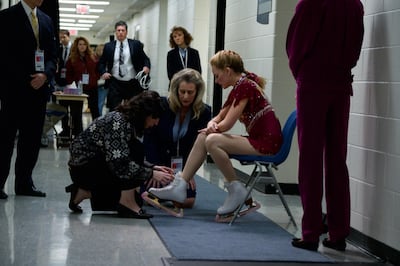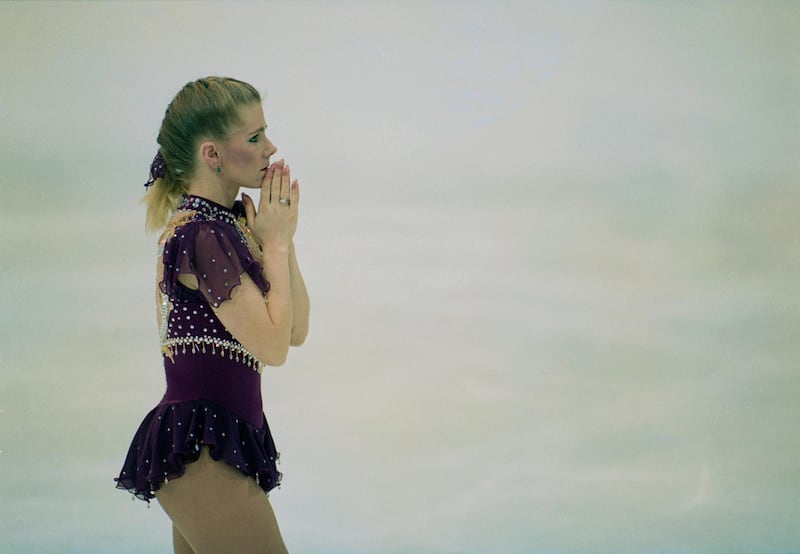Tonya Harding was one of the most controversial sporting figures of the late-20th century, and surely the most infamous character ever to emerge from the normally genteel world of figure skating. Previously, this was a sport whose greatest-ever controversy was probably Jane Torvill and Christopher Dean's ever-so-slightly racy gold medal-winning performance of Ravel's Boléro at the 1984 Sarajevo Winter Olympics which, despite very gently nudging at the boundaries of creativity allowed in the highly technical Olympic sport, still became the highest scoring ice dance routine ever, including perfect sixes across the board for artistic impression. The music the pair selected for their routine was reportedly 18 seconds longer than permitted under Olympic rules, so they knelt for the first 18 seconds, as the clock only starts when the blades touch the ice.
Ten years later, when the practice of kneecapping an opponent entered the figure skating lexicon just weeks before the 1994 Lillehammer Winter Olympics, the sport was understandably aghast. Figure skater Nancy Kerrigan was already America’s sweetheart when she was attacked at a training session, so when the trail led back to Shawn Eckardt, Harding’s bodyguard, and her ex-husband Jeff Gillooly, the writing was on the wall.
Harding was already something of an outsider in the sport due to her trailer park upbringing and propensity for garish, revealing outfits rather than the prim middle-class attire of her peers. She was an ugly duckling among the sport's elegant dancing swans, despite being a talented skater, and she was rapidly elevated to public enemy number-one status following the attack, at least until O J Simpson was accused of the murder of his ex-wife Nicole Brown Simpson and waiter Ronald Goldman later in the year.
In a sense, Harding has been quite harshly judged by history. It should be remembered that Harding was only found guilty of “conspiring to hinder prosecution”. She failed to inform the FBI the moment that she learned her associates were behind the attack – Gillooly thought he could win favour with his ex by removing her main opposition, and Eckardt saw a future gap in the market for a speciality security service for figure skaters.
The prosecution believed Harding was more heavily involved, but accepted the court’s findings, and Harding maintains to this day that she only learned of the pair’s actions after the event.
Nonetheless, many people remember Harding as “that skater who crippled her opponent”. This is wrong on two fronts – firstly, Harding was unequivocally not a participant in the attack, and proven to be unaware of it beforehand. Secondly, Kerrigan was not actually injured too seriously. In keeping with the farcical element of the tale, the man initially hired to attack her could not recognise her at the ice rink, and then missed her knee, bruising her thigh instead. Kerrigan went on to recover and win silver at Lillehammer. Harding finished eighth for added poetic justice.

Director Craig Gillespie and writer Steven Rogers have tried to use these facts as the basis for their version of the story, I, Tonya, rather than the cable channel documentaries and docudramas that clogged 1990s airwaves with a good vs evil tale of the denim-clad, foul-mouthed and, yes, working-class conspiring against the butter-wouldn't-melt, all-American heroine. It was Luke vs Vader with chiffon and twirls, and the public loved it.
Rogers conducted hours of interviews with both Harding and Gillooly before he completed his script, and certainly gives us far more than a pantomime villain in Margot Robbie’s Tonya.
The real-life Harding was a tragic character. She was raised in poverty by an abusive and physically violent mother who saw her success as a figure skater purely as a financial opportunity, and then she was married to a violent and abusive husband whom she claims gang raped her and held her at gunpoint to force her to stay quiet about the attack on Kerrigan, once she knew the facts.
If there’s one criticism of Gillespie’s film, it lies not in its portrayal of Harding as a rounded, and troubled, character with a horrific past, but in the way it portrays that past. Gillespie doesn’t pull any punches in Harding’s abuse, but at the same time he often seems to play it for laughs, trivialising it with humour and fourth-wall breaking asides that undermine its horror.
_________________
Read more:
Here are the UAE cinema release dates for the 2018 Oscar buzz films
In awards season, look to Hollywood to understand modern America
Martin McDonagh on how a 20-year journey ends in Ebbing, Missouri
_________________
Gillespie has claimed this approach is to show how utterly desensitised to abuse Harding was, but the result is that Harding’s mother LaVona Golden (Allison Jenney) comes across almost as a firm but fair parent, whose daughter is meant to suffer in the short-term for long-term gains.
Gillooley (Sebastian Stan) is portrayed as a horrific rapist in one scene, then a loving husband in the next, pushing his beloved on to ever greater achievements. The abuse victim cliché of “they only did it because they love me” plays out, and the narrative that Harding became a great skater as a reaction to her abuse, that she was successful precisely because of it, comes in.
Harding became a great skater through talent and determination. She became an abuse victim through being surrounded from birth by some truly awful human beings. The two should not be confused.
I, Tonya is released in UAE cinemas today





